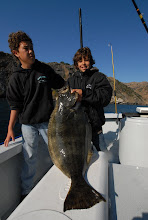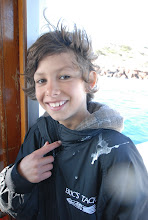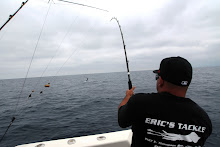Flow of Time Changes River
Article appeared in the Los Angeles Times, Saturday, January 12 1985/Part III
(and edited by Ed Henke in 1998)
Steelhead Fishermen Once found a Paradise Along The Banks of the Ventura. by EARL GUSTKEY, Times Staff Writer.
Ventura--- This is about a noble species of fish, a river that's fallen on hard times and a fisherman who can't forget.
Ed Henke remembers better days for the Ventura River. Henke's name might sound familiar. He played football at USC and was an NFL linebacker for ten seasons, most of them with the San Francisco 49ers, from 1949 to 1963.
He grew up in Ventura, a star athlete at the high school and junior college there. But Henke always had a problem with football. As good as he was, it interfered with important stuff, such as winter steelhead fishing on the Ventura River.
The best days of his life, he says, were those in the late 30's and 40's that he spent fishing for 30-inch steelhead on the river, and building driftwood campfires in the evenings on the river's little delta, where the Ventura flows into the sea. There, Henke and his friends watched summer sunsets outline the channel islands against fading horizons, not knowing their steelhead river was about to fade away, too.
"We were awfully innocent then," he said recently. "We never knew there'd be dams on the river. There was a bad drought in the late-1940's, and before we knew it there was a dam being built in 1946 on Lower Matillija Creek. That knocked the steelhead runs in half immediately. It was the beginning of the end."
Henke lives in Northern California now, and fishes for steelhead on a couple of North Coast streams, the Smith and Klamath. But he keeps in touch with his old river through membership in Friends of the Ventura River organization.
"When I was a kid, in the 1930's and 40's, the Ventura was more than a river," Henke recalled. "It was a treasure. It belonged to all of us in Ventura. When the steelhead were running, the river brought us all together, all ethnic groups and nationalities. I had a lot of Spanish, Mexican-American and Portuguese friends I met on the river and fished with for years. We even saw the Chief of Police on the river a lot, fishing.
"One old guy who taught me how to fish was an old Portuguese guy, Joe Orniega. He was in his 50's or 60's then, and had been around Ventura since the 19th Century. He liked to fish the surf, at the mouth of the river."
I fished a lot with the Pierano brothers, who ran and owned the grocery store across the street from the Ventura Mission.
"We used to take our rods to school. Afterward, it was a nickel bus ride to the Ventura Oil Fields where we'd get out and walk three miles to Foster Park. It was another four or five miles to Coyote Creek and we'd walk there too.
"I'd fish until dark and often caught steelhead running 15 to 20 inches. There was one that went 29 inches. When I fly fished, it was a wingless royal coachman fly. But those things never worked until one of us tore the wings off one day.
"The opening day of the fishing season was practically a holiday. A note from a parent got you out of school for the day, if you wanted to fish.
"Geez, I can remember in the late 40's, looking down in some pools of the Santa Ana Creek (a major Ventura tributary), and seeing layers of steelhead stacked up like cord wood.
"We hiked into the back country in the Summers, along the creeks, looking for holes with land-locked steelhead. Upper Santa Ana Creek, Upper San Antonio Creek, that was where there spawning grounds were. We found 25-30 inch fish back in there.
"And in those days, the Ventura wasn't the only steelhead stream we had. We had the Santa Ynez and the Santa Clara rivers too. One of the best steelhead spots in the entire Santa Barbara-Ventura area was Upper Santa Cruz Creek, a tributary of the Santa Ynez. The creek was wiped out when they built Lake Cachuma.
"In 1946, on opening day of the fishing season, I caught 13 steelhead before 9 a.m. on Upper Santa Cruz Creek. They were all 24 to 28 inches. One day in 1945, my brother and I brought home five over 34 inches from Upper Santa Cruz. In the winter, fish that size would weigh 20 pounds, but they say they were more like nine in the summer.
"The Santa Clara used to be a tremendous steelhead river. At the mouth, we used to fish the surf, with spinners and casting rods. I remember a day when my best friend caught a 13 pounder in the surf right at the Santa Clara mouth. I even remember what he used, a No. 3 copper spinner.
"We caught salmon occasionally in all those streams, but they were basically steelhead waters. Today, you could find people in Ventura who've lived there for years who'd be surprised if you told them you could still find steelhead in the river.
"But, when I was a kid, it was a part of your life in Ventura. Fishermen from all over Southern California filled up the hotels when the steelhead were running.
"Now, the river's kind of a down on its luck from what it was. But it's nice to know there are at least a few steelhead coming back every year. And it's nice that some of the people down there are trying to hold on to them, and maybe even increase the steelhead numbers. But it can never be what it was.
"Let me tell you this. The winter before they built the Matillija Dam, I remember hiking back up there and counting 125 big adult steelhead-just the ones I could see-- in several deep holes. The winter after the dam was built, I hiked back up there and obiously there was none one to be seen. I cried. I mean, I really cried. We thought we'd have steelhead forever. It cut my heart out."
*************
A steelhead is an ocean-going rainbow trout. Its life cycle is similar to a salmon's except for one major difference: It doesn't necessarily die after spawning.
Juvenile steelhead normally spend a year or two in a stream before migrating to the ocean. Some wait a third year. Some, for no known reason, never leave the river.
In the ocean, steelhead grow rapidly. Unlike salmon, which remain relatively close to the coast, steelhead venture thousands of miles into the Pacific. They feed on small fish, krill and crustaceans.
They return to spawn in the stream of their birth after one or two seasons in the ocean. Most California steelhead are known as winter and fall run fish, meaning they attempt to re-enter the rivers in fall and winter when heavy rainfall produces high-volume flows that break apart sand bars blocking river mouths.
In the case of larger rivers with year-round flows, where sand bars seldom block the mouths, the re-entry of steelhead is less predictable.
At sea, steelhead are steel blue on the back with bright silver sides. There are sharply defined black spots on the back, head, sides and dorsal and caudal fins.
In fresh water, steelhead develop more like stream rainbows. The back becomes olive green, the sides are less silvery.
Most steelhead caught by fishermen weigh less than 10 pounds, but fish weighing more than 20 pounds are sometimes caught on North Coast streams. On Alaskan streams, they have exceeded 40 pounds.
Steelhead populations can be an accurate barometer of the impact of man on the river:
--Smith River, Del Norte County -No dams, no industry, very little riverside development, high flows. Results. An estimated 25,000 steelhead enter the river every winter.
--Ventura River-- Two dams, a diversion canal, considerable industry and development, low flow. Results. very few steelhead a year, down from the 4,000 to 5,000 annually in the 1940's
*************************
The Ventura River has been in a slump for 203 years. The river got along fine with the Chumash Indians who lived along side and were nourished by the river for thousands of years.
But since the day in 1782 when the Franciscan Padres at the new San Buenaventura Mission opened the gates to their six-mile-long wooden aqueduct at the mouth of Canada Largo Creek, a Ventura River tributary, man has been removing water from the river.
He's also been dumping toxic substances into it for a long time, building dams and re-routing the river into impoundments, building housing developments next to it, tearing up its stream bed with bulldozers.
Incredibly, a few adult steelhead will return to the Ventura River system to spawn..
The pressure on the Ventura River, which drains 228 square miles of the Coast Range, slowly grew when first Mexican and then American farm settlements in the Ventura area were hit hard by droughts in the 1890's
In the drought of 1863-64, according to local historian R. G. Percy, 195,000 of 200,000 cattle perished. Ranchos sold for $2.00 and acre and less. It was estimated at the time that there wasn't $6,000 in cash in all of Santa Barbara County.
Oil was discovered in Ventura in 1916. A tiny farm town quickly became a little oil boom town. Serious discussion of a major water impoundment above the fertile valley North of Ventura began about 1925.
The eventual result was the Casitas Reservoir, filled in 1959. In terms of steelhead runs, of all the encroachments man had made on the river, this was the most telling, the knockout punch. In the few months it took to fill Casitas, Southern California's last good steehead river became a memory
The construction of Casitas was preceded by another major reversal for steelhead---the completion of Matillija dam in 1948 on Upper Matillija Creek, a major steelhead spawning tributary.
The succession of blows to the Ventura's steelhead runs seemed to stop around 1970. In fact, in recent years, the Ventura has won a few battles.
--In 1969, a suit was successfully brought against Shell Oil Co. for discharging ammonia into the river.
--In 1971, a planned shopping center on the river's delta that would have encroached on critical flood plain areas at the delta was blocked. That effort spawned the birth of Friends of the Ventura River, a 500-member Organization that has led other battles to prevent further encroachment on the river.
--In 1974, a cement plant was planned for a riverside site just north of the city. It, too, was defeated.
--In 1976, Friends of the Ventura River unsuccessfully tried to remove a sand and gravel mining operation from the bed of the river a few miles north of the city. The mining continues but under regulations requiring mining to occur no closer than 100 feet from the water line.
--In 1979, a waist treatment plant was discharging raw waste into the river near the city itself. Discharge requirements were stiffened and a new plant was built.
--In 1979, a mobile home park was planned for a bluff above San Antonio Creek, a major tributary. Friends defeated the the proposal. A Girl Scout camp is there today.
Earlier this month, Friends of the Ventura won its biggest battle. A year ago, it filed suit against the Casitas Municipal Water District, asking that the district be prevented from carrying out an announced plan to extract even more water from the river. In Ventura Superior Court, Judge Joe Hadden ruled for Friends of the Ventura River, stating that the water district's plan failed to comply with California environmental law.
Friends of the Ventura River is undertaking other projects, hoping to return the river to at least a semblance of what it must have been when the padres built their wooden aqueduct.
***********************************
There is one last glimpse remaining of what the Ventura River system once looked like, when shadows of condors often flickered across the river. Matillija Hot Springs is a small canyon resort on Matillija Creek, just off Highway 33, near Ojai. There's been been a resort here since 1871. Here, Lower Matillija Creek flows around huge boulders, under a canopy of old eucalyptus, willow, sycamore, cottonwood, alders and oaks.
The image of big, ocean-fattened steehead battling their way upstream here, seeking that part of the creek where they were spawned, isn't difficult to imagine. Once, half of all steelheads in the Ventura River spawned in 23-mile-long Matillija Creek.
It's only a mile from the Hot Springs to the dam holding up Matillija Reservoir.
Only a mile -- and 203 years.
The Ventura River. It's one that got away.




















































.jpg)


















